
Mercury's evening show in the Northern Hemisphere
BY MARK ARMSTRONG
ASTRONOMY NOW
Posted: 19 May 2014

Mercury is well positioned now in the evening sky, putting on its best showing of the year for Northern Hemisphere observers. Fleet-footed Mercury, the innermost planet, reaches greatest eastern elongation (23 degrees) from the Sun on 25 May but it's in the evening sky now and will remain there for the rest of the month.

Mercury and Jupiter are visible in the evening sky. Astronomy Now graphic by Greg Smye-Rumsby.
Many astronomers have never seen Mercury but that's not really surprising as it never strays more than 28 degrees from the Sun, so it's only ever visible close to the horizon at dawn or dusk, often subject to poor seeing. If you have a relatively clear, unobstructed western/northwestern horizon then try to take any opportunity to see it.
Around the 20 May the Sun sets at 8.50pm from London and 45 minutes later in the deepening twilight Mercury will be ten degrees above the west-northwestern horizon between the stars marking Taurus' horns. Mercury should be easy to spot with the naked eye in haze and murk-free conditions, shining at mag. -0.02; if you have a pair of binoculars to hand then sweep for it. Half-phase (Dichotomy) occurs on 19 May with the planet 7.2 arcseconds in apparent diameter and a small telescope will easily show this phase in moments of steadier seeing. Remember never search for Mercury or any astronomical body close to the Sun until the Sun has set. Irreparable damage to your eyesight can easily occur if the Sun enters the field of view of your eyepiece or binoculars.
Mercury fades as May wears on as its apparent diameter increases and phase decreases. By greatest elongation on 25 May the planet is still around 10 degrees above the horizon some 45 minutes after local sunset. It will be slightly harder to spot being over half a magnitude dimmer at +0.57; its phase is now a broad crescent 35 percent-illuminated. At the month's end the innermost planet will have faded significantly to mag. +1.3 and be three degrees worse off in terms of altitude for the same degree of twilight. If you can get a 'scope on it then you will see a beautiful crescent (phase 23 percent) nearly ten arcseconds in apparent diameter.
The Solar System's biggest planet, the gas giant Jupiter is also in the evening sky but is more prominent, being much brighter and at a higher altitude. They are joined by the young crescent Moon for the last two days of May.
North America
Observers hunting down Mercury will benefit from a few extra precious degrees of altitude making it easier to spot in the gathering twilight and potentially better seeing conditions. From New York latitudes, look for the planet around 35 minutes after local sunset when it will be 13 degrees up. Further south (latitude 30 degrees north) the planet may be glimpsed earlier, some 25 minutes after sunset when it will be 15 degrees clear of the west-north-western horizon.
Australia and New Zealand
Mercury puts on quite a good show despite this evening apparition not being the year's best, that being reserved for September's apparition. From Sydney, Mercury can be seen 7 to 8 degrees above the north-western horizon 30 minutes after sunset. By the month's end elusive Mercury will about a degree west of Messier 35, the great open cluster in Gemini; its altitude around 5.20pm will be about 10 degrees so given good conditions and a good horizon this will be a nice observation to make.
As already mentioned the changing phases are easy to see in a small telescope and low contrast, indistinct surface markings can be seen in good conditions with apertures above 130-mm. Colour filters should certainly be tried with orange, red and deep red best; one caveat is that the later cuts out most light and is best employed on larger scopes in the 250-mm and upwards class, where sheer light grasp offsets the filter's attenuation. If you can observe with a larger aperture then have a go at sketching Mercury or some high resolution imaging, especially if your seeing conditions appear favourable. Why not have a go at securing some simple snap shots with your digital SLR camera?
|



